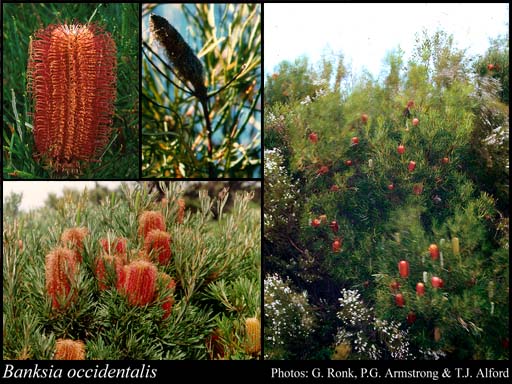- Reference
- Trans.Linn.Soc.London 10:172 (1810)
- Conservation Code
- Not threatened
- Naturalised Status
- Native to Western Australia
- Name Status
- Current
Non-lignotuberous, small tree or shrub, 1-7 m high. Fl. yellow & orange & red, Sep to Dec or Jan to May. Sand or peaty sand. Low-lying areas, swamps, seepage areas, consolidated sand dunes.

Scientific Description
Shrubs, 1.5-4 m high; branchlets glabrous or hairy. Leaves petiolate, whorled, 30-105 mm long, 2-4 mm wide, hairy; petiole 0 mm long; lamina flat, more or less the same width throughout, once divided, pinnately divided or divided only at the apex, shallowly divided, teeth distinctly pointing towards the apex, with 1-4 lobes on each side, the margins recurved or revolute. Inflorescences tomentose (with matted or tangled, soft, woolly hairs), yellow or red; innermost bracts 7-10 mm long, hairy. Perianth 18-27 mm long, hairy, all over, limb apex pubescent (with soft, straight, erect hairs), without awns; pistil 36-41 mm long, hooked, style glabrous. Follicles hairy, hirsute (with long, rough and coarse hairs), elliptic, 10-18 mm long. Flowers in January, February, March, April, May, September, October, November or December. Occurs in the South-west (SW) Botanical Province(s), in the Jarrah Forest (JF), Mallee (MAL), Warren (WAR) or Esperance Plains (ESP) IBRA subregion(s).
Distribution
- IBRA Regions
- Esperance Plains, Jarrah Forest, Mallee, Warren.
- IBRA Subregions
- Eastern Mallee, Fitzgerald, Recherche, Southern Jarrah Forest, Warren.
- IMCRA Regions
- Leeuwin-Naturaliste, WA South Coast.
- Local Government Areas (LGAs)
- Albany, Augusta Margaret River, Denmark, Esperance, Manjimup, Nannup, Plantagenet, Ravensthorpe.